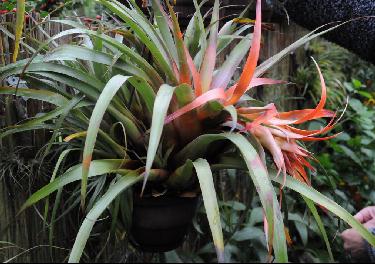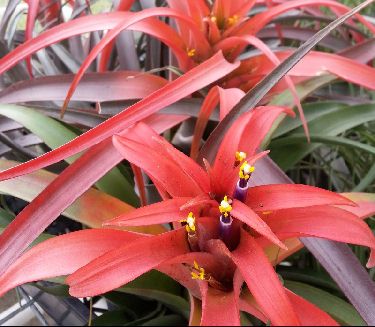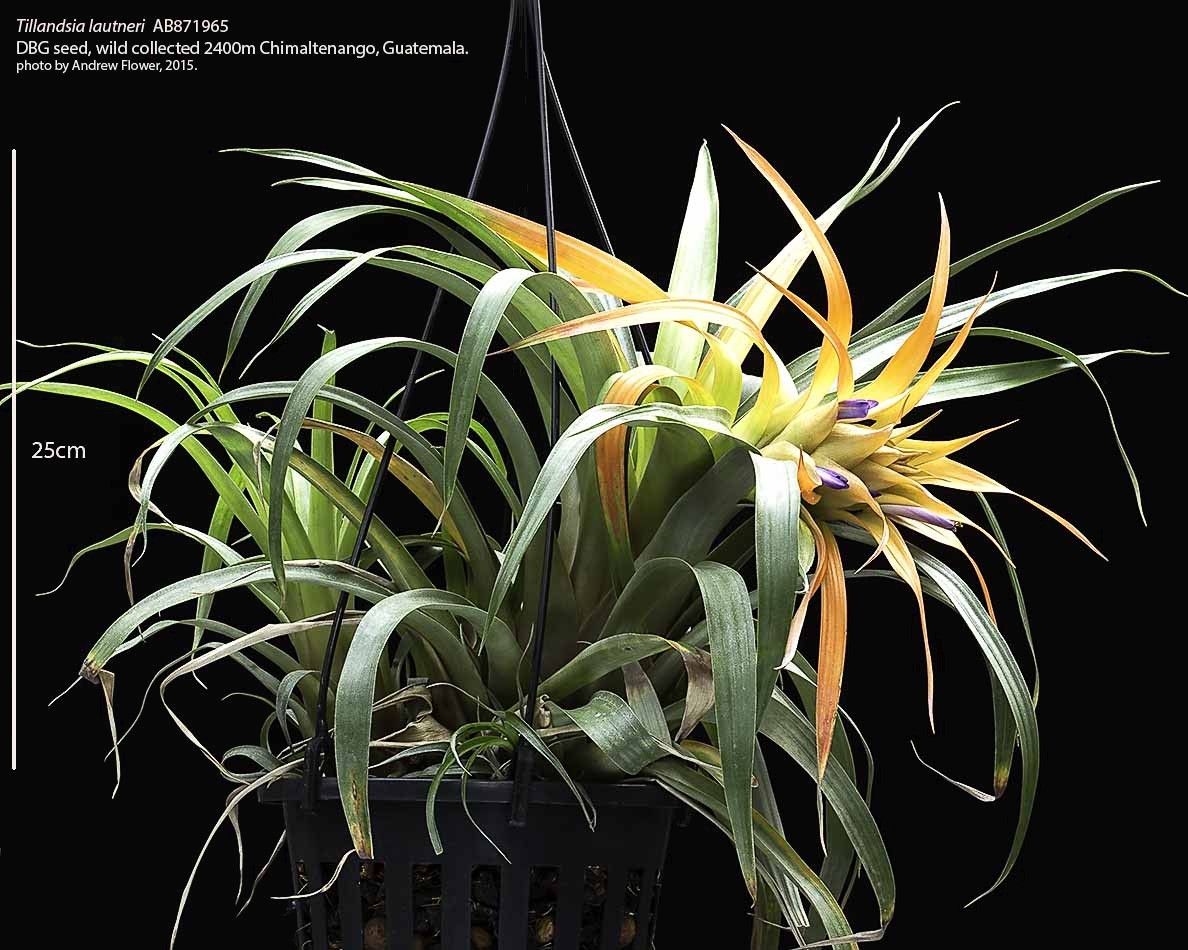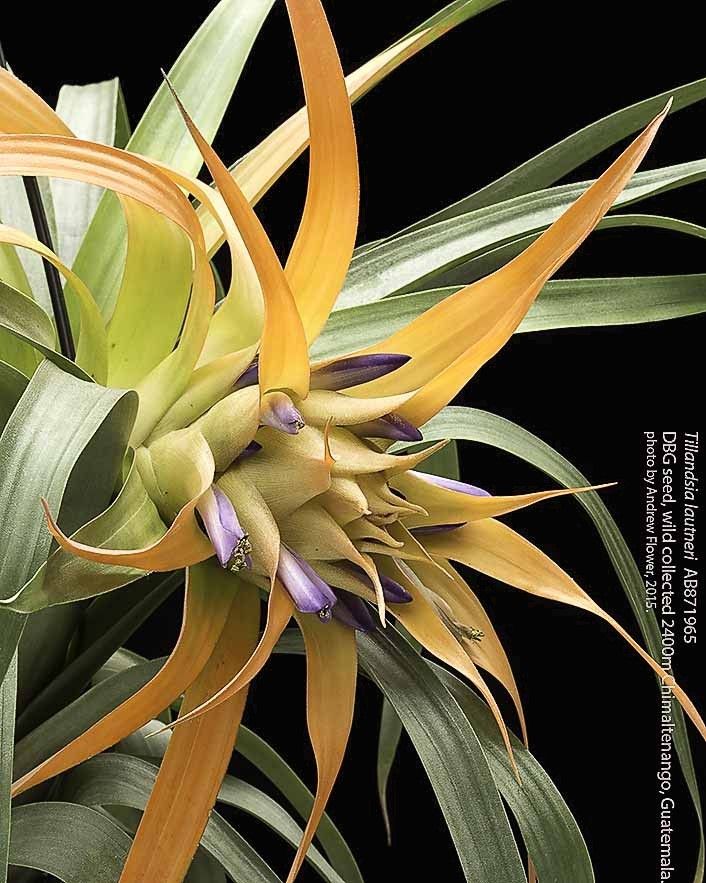Tillandsia lautneri
Click thumbnails for full size, scaled to a new window.
Tillandsia lautneri
Formerly T.capitata var guzmanoides ("though Renate may be still working on it, or possibly revising/resurrecting it.")
Guatemala, Cunen, Sierra de Cuchumatanes




| Peter Tristram 07/09. |
Chris Larson 12/12. As T. capitata var guzmanoides |
Chris Larson 10/14. As T. capitata var guzmanoides |
Chris Larson 12/12..."Another capitata. Plant is ex-Feldhoff in Guatemala via Germany this year.
This one I think is supposed to be the true T.capitata var guzmanoides though Renate may be still working on it, or possibly revising/resurrecting it.
Note that the 2012 Bi-nomials does not list a T.capitata var guzmanoides which was reclassified as T.lautneri quite some time ago.
Derek Butcher 12/12...."Chris - The good old DVD tells us that T. lautneri has stamens that do not exsert and the plant is bulbose. There are no doubt other differences in a closer look at the flower. Therefore it is closer to the very variable T. capitata."
Chris Larson 10/14..."I just thought Id post these photos as some who trawl eBay will have seen them but others havent.
The story started with Peter Tristram & I importing some plants of Guatemalan origin out of Europe. We both got a couple of T. capitata var guzmanoides which were a nice darker clone with scarlet bracts and definitely not var guzmanoides. These flowered at a smaller size, at least mine did, at around 12 tall. It also self set seed.
Then I got offered some more expensive Guatemalan plants (than our usual lines) as a one off which included this var guzmanoides again. I only got a few. Some flowered at around 45cm tall with scarlet bracts and are just starting to pup. Monster capitatas as those that have seen them will attest. A few nutters have them now. I thought Id better put this info out as these plants will be appearing around.
Im still not sure whether to register it as T. capitata 'Scarlet' as Im not sure that the 2 clones I have are not the same or what will happen with the pups."
Derek Butcher 11/14...."The only ones really interested in blatant wrong names seems to be we Antipodeans! Bromeliads in Australia has the problem partly solved because the right detail are under T. lautneri. Feldhoff started off this misnaming. The use of Scarlet is a nurseryman's solution but is frowned upon by Registrars. Why not call this 'Feldhoff'? It identifies the source AND that it is different."
Elm Mema 06/17...."Our plant labelled T. lautneri is blooming, but we found that it is not the real T. lautneri. It has exsert stamen and not bulbose.
It looks like Chris Larson photos in T. lautneri article (see above). I've not found the named conclusion of this plant yet.
May I called this plant as T. 'Feldhoff' as your last comment ? Please advise."
Derek Butcher 06/17...."It seems that T. 'Feldhoff' is getting around the world and perhaps something needs to go in the BCR warning of this 'mistake'."
Editor 07/17.... Please see T. capitata page for further discussion. It seems that a plant labelled T. capitata var guzmanoides was placed in synonmy with T. lautneri at some point. This process seems to have been followed for ALL T. capitata var guzmanoides. It seems now that many labelled T. capitata var guzmanoides are NOT T. lautneri but, to further complicate things, the real T. capitata var guzmanoides is being quetioned, needs to be better defined, and may be reaised to species level rather than a var.

 Andrew Flower ... "Plant grown from seed 2001 ex German Bromeliad Society, labelled " T. lautneri. Grosse form, Guatemala 1997. Chimaltenango, 2400 m, L97/13 kuhl, ziemilch feucht." (note how long they had the seed in storage before I got it). Temperature graph is from Chimaltenango city, which is 1800 m. up. I take the German to translate roughly: large form.... cool, reasonably humid.
Andrew Flower ... "Plant grown from seed 2001 ex German Bromeliad Society, labelled " T. lautneri. Grosse form, Guatemala 1997. Chimaltenango, 2400 m, L97/13 kuhl, ziemilch feucht." (note how long they had the seed in storage before I got it). Temperature graph is from Chimaltenango city, which is 1800 m. up. I take the German to translate roughly: large form.... cool, reasonably humid.
This taxon was known for a long time as Tillandsia capitata var. guzmanoides (L.B. Smith, 1939 and Matuda), however in 1993 Renate Ehlers pointed out that it had basically no resemblance to T. capitata, rather it was close to the T. sierra-juaraensis/violaea community.
Only one seed germinated for me, and I very nearly killed it off one winter (all its pups rotted off before I saw it and shifted it to a warmer area with better air circulation) but luckily it survived.
Species named for Jurgen Lautner, who collected the seed my plant was grown from."
Tillandsia lautneri, R Ehlers, Die Bromelie 2; 38-40. 1993
syn T. capitata var. guzmanioides L B Smith (Matuda 2308)
Translated by Butcher from the German
Plant stemless, to 30cm high, 15cm diam, growing in groups with small basal offsets, making a narrow, erect, sub-bulbose rosette.
Leaves numerous, soft and very thin, dark green, with striking black brown sheaths.
Sheaths to 12cm long, to 6cm wide, elliptic, spoonshaped, arched, distinct from the blade, both sides small punctulate lepidote.
Blades about 2.5cm wide above the sheath, to 15cm long, triangular acuminate, erect, dark green, the edges reddish brown and bent, with a weak asymmetric keel, adaxial (inside) shiny, with fine punctulate scales, abaxial (outside) strongly nerved, and with dense grey appressed scales.
Scape to 6cm long, bent over, wholly covered by the leaves.
Scape bracts densely covering the scape, to 20cm long, subfoliate, becoming erect.
Inflorescence compound, bipinnate, to 7cm long, to 5cm wide, ellipsoid-capitate, to 10 20 sessile, dense, erect, spikes.
Primary bracts similar to scape bracts, ca. as long as the spikes, which are inserted on the flat side, the upper gradually becoming shorter and with triangular blade, thin membranous, shiny red or orange.
Spike to 3cm long, to 1.6cm wide, oval, complanate, mostly 2 flowered, with an extra 2 sterile bracts at the base and one apical, thin stemmed, stunted flower, the lower and upper spikes mostly reduced to 1 flower.
Flower bract 1.5 1.9 (- 2.5)cm long, 6 10 ( -12)mm wide, oval, acute, very thin membranous, inside nerved, outside green red, finely scaled, keeled, 1 3mm shorter than the sepal.
Sepal 1.8 2.2cm long, 6 7mm wide, lancelike acuminate, thin membranous, almost free (uniformly joined for about 2mm), all keeled, nerved, finely punctulate lepidote.
Petal 7 7.7cm long, 6 7mm wide, narrowing to 4mm at base, tongue-shaped, forming an erect tube, the tips erect and not bent sharply outwards, two coloured, the top 1/3 violet (#54) with white edges, then becoming white.
Stamens as long or shorter than the flower tube. Style longer than the filament, 7cm long, thin, white. Lobes small, a little wider than the style, erect, violet ( Type I B&G). Filaments in 2 rows of unequal length, to 6.5 cm long, the upper portion 0.75mm wide, flat-oval, narrowing to the base, straight, white. Anthers erect, 3mm long, 1mm wide, joined almost at the base, dark brown. Pollen egg yellow.
Ovary 8mm high, 3mm wide at base, conical, triangular in cross section, light green.
Type locality Guatemala, Dept. Huehuetenango, Sierra Los Cuchumatanes, km343, 2350m, leg Jurgen Lautner, L91/6, 10th March 1991, epiphytic on Pinetrees. (Holotype and Isotype WU)
Habitat and range: Southern Mexico and Guatemala.
Other material cited. Bot Gardens Herb Sarasota, Hill (Jnr) 6/7/1980 near St Christobal, Chiapas, Mex. and Bush & Burch Nov 1980 near San Cristobal on road towards Palenque at 2300m.
Differs from T capitata in
1. Habit slightly bulbose.
2. Leaves dark green with dark brown sheaths.
3. Flower bracts smaller and thin and shorter than the sepals.
4. Sepals almost free.
5. Stamens included
Differs from T. sierrajuarezensis in
1. Spikes shorter (only 2 flowered)
2. Primary bracts longer
3. Flower bracts much shorter, punctulate lepidote.
4. Petals longer and bi-coloured (violet with white base and tip)
5. Stamens included
The plant is named after Botanical Garden Supervisor Jurgen Lautner. In the Botanic Garden of Gottingen, he has taken care of the Bromeliads for many years and on many trips to Mexico and Guatemala he has discovered several unknown Tillandsias.
Although very clearly the plant has a large number of characteristics distinguishing it from T. capitata, it is identical to T. capitata var. guzmanioides L. B. Smith. The author made it a variety on one single characteristic, namely scaled sepals, of T. capitata Grisebach.
Harry Luther advised me that years ago, Sue Gardner had already deposited at the herbarium of the Sarasota Botanical Gardens, material classified as T. capitata var. guzmanioides ( Hill Jr. s. n., 6. July 1980, Mexico, Chiapas, near St. Christobal, and Bush & Burch s. n., Nov 1980 Chiapas, near San Cristobal on the way to Palenque 2300 m). I determined that it was not a var. of T. capitata but should be published as a species and status nova.
Updated 06/07/17





